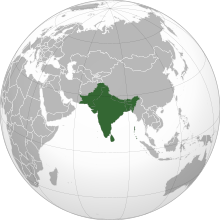Our website is made possible by displaying online advertisements to our visitors.
Please consider supporting us by disabling your ad blocker.
Indijski potkontinent
| Indijski potkontinent | |
|---|---|
 Geopolitičko pokrivanje potkontinenta | |
| Površina | 4.440.000 km2 |
| Br. stanovnika | oko 1.8 milijardi |
| Demonim | Južni Azijati Desi |
| Države | |
| Zavisne teritorije | Spisak |
| Jezici | Jezici južne Azije |
| Vremenske zone | UTC +6 UTC +5:45 UTC +5:30 UTC +5 |
| Najveći gradovi | |
Indijski potkontinent[a] jest fiziografska regija u južnoj Aziji, uglavnom smještena na Indijskoj ploči, koja se sa Himalaja pruža prema jugu u Indijski okean. Geopolitički, obuhvata velike kopnene mase zemalja Bangladeša, Butana, Indije, Maldiva, Nepala, Pakistana, i Šri Lanke.[1][2][3][4] Iako se termini "indijski potkontinent" i "južna Azija" često koriste naizmjenično za označavanje regiona, geopolitički termin Južne Azije često uključuje Afganistan, što se ne smatra dijelom potkontinenta.[5]
Geološki, potkontinent potiče iz Indijskog ostrva, izolovane kopnene mase koja se odvojila od superkontinenta Gondvane tokom krede i spojila se sa kopnom Evroazije prije skoro 55 miliona godina, formirajući Himalaje.[6] Historijski gledano, kao i do danas, to je i bio i idalje jeste najnaseljenija regija na svijetu, u kojoj živi otprilike 20-25% globalne populacije u svim vremenima u historiji. Geografski, to je poluostrvo u južnoj Aziji smješteno ispod Trećeg pola, ocrtano Himalajima na sjeveru, Hindukušom na zapadu i Indo-Burmanskim planinskim lancima na istoku.[7] Susjedne geografske regije oko potkontinenta uključuju Tibetansku visoravan na sjeveru, Indokinesko poluostrvo na istoku, Iransku visoravan na zapadu i Indijski okean na jugu.
Greška kod citiranja: <ref> oznake postoje za grupu pod imenom "lower-alpha", ali nije pronađena pripadajuća <references group="lower-alpha"/> oznaka, ili zatvarajući </ref> nedostaje
- ^ "Indian subcontinent". New Oxford Dictionary of English (ISBN 0-19-860441-6) New York: Oxford University Press, 2001; p. 929: "the part of Asia south of the Himalayas which forms a peninsula extending into the Indian Ocean, between the Arabian Sea and the Bay of Bengal. Historically forming the whole territory of Greater India, the region is now divided into three countries named Bangladesh, India and Pakistan."
- ^ Dhavendra Kumar (2012). Genomics and Health in the Developing World. Oxford University Press. str. 889. ISBN 978-0-19-537475-9.
- ^ Mariam Pirbhai (2009). Mythologies of Migration, Vocabularies of Indenture: Novels of the South Asian Diaspora in Africa, the Caribbean, and Asia-Pacific. University of Toronto Press. str. 14. ISBN 978-0-8020-9964-8.
- ^ Michael Mann (2014). South Asia's Modern History: Thematic Perspectives. Taylor & Francis. str. 13–15. ISBN 978-1-317-62445-5.
- ^ John McLeod, The history of India, page 1, Greenwood Publishing Group, 2002, ISBN 0-313-31459-4; note: McLeod does not include Afghanistan in Indian subcontinent or South Asia;
Jim Norwine & Alfonso González, The Third World: states of mind and being, pages 209, Taylor & Francis, 1988, ISBN 0-04-910121-8 Quote: ""The term "South Asia" also signifies the Indian Subcontinent""
Raj S. Bhopal, Ethnicity, race, and health in multicultural societies, pages 33, Oxford University Press, 2007, ISBN 0-19-856817-7; Quote: "The term South Asian refers to populations originating from the Indian subcontinent, effectively India, Pakistan, Bangladesh and Sri Lanka;
Lucian W. Pye & Mary W. Pye, Asian Power and Politics, pages 133, Harvard University Press, 1985, ISBN 0-674-04979-9 Quote: "The complex culture of the Indian subcontinent, or South Asia, presents a tradition comparable to Confucianism."
Mark Juergensmeyer, The Oxford handbook of global religions, pages 465, Oxford University Press US, 2006, ISBN 0-19-513798-1
Sugata Bose & Ayesha Jalal, Modern South Asia, page 3, Routledge, 2004, ISBN 0-415-30787-2 - ^ Robert Wynn Jones (2011). Applications of Palaeontology: Techniques and Case Studies. Cambridge University Press. str. 267–271. ISBN 978-1-139-49920-0.
- ^ Baker, Kathleen M.; Chapman, Graham P. (11. 3. 2002), The Changing Geography of Asia, Routledge, str. 10–, ISBN 978-1-134-93384-6,
This greater India is well defined in terms of topography; it is the Indian sub-continent, hemmed in by the Himalayas on the north, the Hindu Khush in the west and the Arakanese in the east.
Previous Page Next Page


